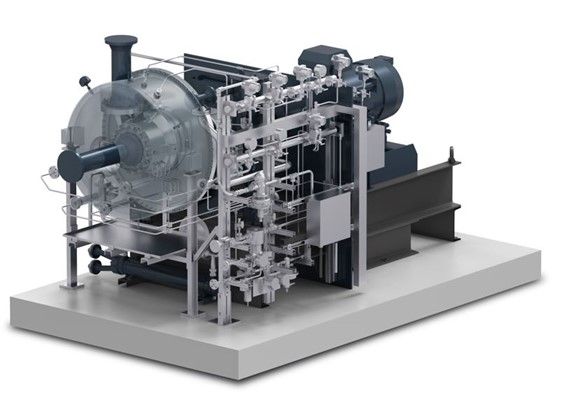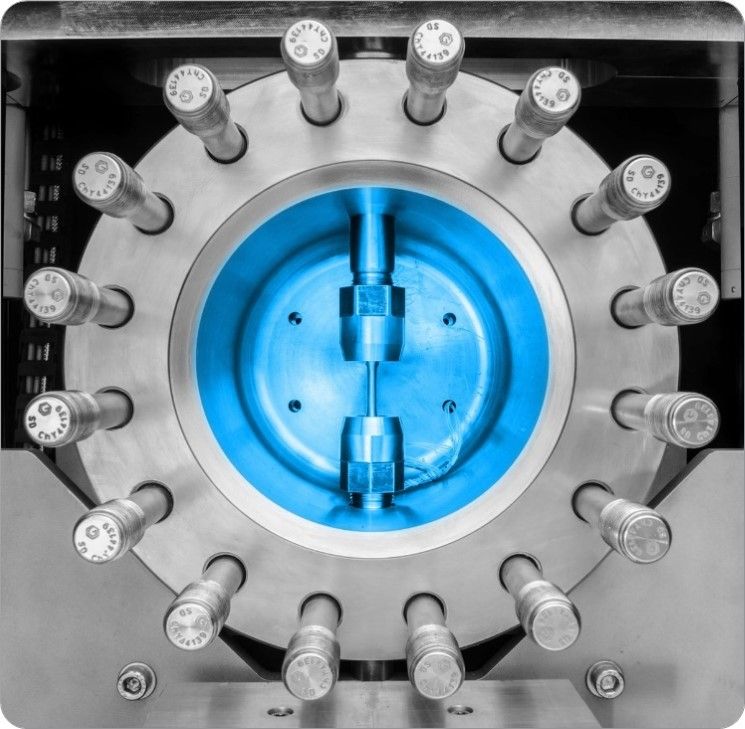Hydrogen Compression
The pilot carrier vessel transporting liquefied hydrogen from Australia to Japan. Photo courtesy of HySTRA.

BY FRANCESCO LA PORTA AND HIDENOBU USUDA
Hydrogen presents opportunities as a clean energy source, either used as storage or as fuel in mobility, or as a feedstock in refineries and petrochemical processes. But there are many challenges to overcome, many of which revolve around the cost-effectiveness and reliability of hydrogen storage and transportation technology. Kawasaki
Heavy Industries (KHI) recently conducted a pilot study on hydrogen transportation. A new KHI carrier transported hydrogen 9,000 km from the eastern coast of Australia to Kobe, Japan. Of the many challenges examined during the sea voyage, the most vital was testing the Atlas Copco Gas and Process centrifugal compressor for boil off gas (BOG) that ensures hydrogen remains chilled at -253° C in liquid form.
There are three main types of hydrogen: grey, blue and green. Grey hydrogen is typically a by-product from fossil fuels, the use of which releases vast amounts of CO2 directly into the atmosphere. This form of hydrogen production comes with lower costs but is less environmentally desirable than blue hydrogen (which is also fossil fuel-based, but with the CO2 captured, stored and compressed) and green hydrogen (from renewable sources through electrolysis). The hydrogen in the KHI pilot test carried grey hydrogen produced from brown coal. If hydrogen is to have the major future impact, wide-ranging hydrogen storage and transportation solutions are needed.
Hydrogen can be stored as a compressed gas or stored via liquefaction, as it was in the pilot study. The liquid hydrogen was stored on board the 116-meter-long, 8,000-ton vessel in a 1,250-m3 double-shelled, vacuum-insulated single tank. It utilized a high-tech boil-off gas compression system.
BOG compressor technology has long been central to the liquid natural gas (LNG) process. At atmospheric pressure, LNG begins to boil at -165°C when it converts to gas and the pressure in the system increases. At this point it either needs reliquefying and returning to the tank or to be used as a fuel.
A single-stage integrally geared turbo compressor was deployed for the pilot vessel. It supports the H2 loading and offloading process.

COMPRESSOR CHALLENGES
Major challenges emerged in the development of this transportation technology related to the -253° C temperature, and the fact that hydrogen is 800 times more dense in liquid form (LNG is 600 times more dense) than as a gas. Working at such a temperature and density presented engineers with questions about material embrittlement and how to design a reliable seal-gas system to new machine classifications and material qualifications.
University labs and suppliers worked closely with Atlas Copco Gas and Process as part of the development of a liquid hydrogen solution: an open-milled, light-alloy aluminum impeller with a cast S-steel volute vertically split casing and machine plate diffuser. Around the casing was a cutting-edge vacuum insulation solution that ensured oxygen could not liquify from ambient air.
The hydrogen transportation market in shipping is relatively new. As engineers developed the compressor, new classifications and regulations needed to keep pace. A central factor preoccupying Japan’s NKK marine society classification team revolved around safety, focusing mainly on the material choice and leakage prevention.
Materials qualification procedures entailed testing materials down to liquid helium, -269° C: Impact and tensile tests were carried out for materials that contact cold hydrogen. The seal gas system, which also acts as a heating medium, was perhaps the biggest challenge. The compressor required a constant supply of warm hydrogen to prevent condensation and solidification of nitrogen and/or oxygen, which could damage the shaft. As the shaft temperature is so low, primary seal gas consumption is high. Additional heat flow into the shaft is generated by warm oil in the bearing area.
Computational fluid dynamics (CFD) and thermal finite element analysis (FEA) helped engineers evaluate temperature distribution across the shaft. Based on those analyses, thermal flow has been balanced to guarantee safety in all possible operat-ing and emergency scenarios.
Materials testing for the compressor was based on new research and development, supported by work from university labs.

LESSONS LEARNED
In 2020, the prototype KHI carrier completed its sea trials from Australia to Japan. The lessons learned are being used to introduce further improvements. For example, engineers have fitted the compressor with improved insulation materials and eliminated potential sources of leakage. The NKK classification society has approved key components, which are now ready for large-scale production. New hydrogen regulations and material qualifications and classifications have been established. This pilot enabled technological advancements in minimizing leakages, preventing cold bridges and material embrittlement, and creating effective seal gas systems. It boosted the technological case for the cost-effective and reliable storage and transportation of hydrogen.
BOG compressors for future commercial hydrogen carriers are expected to play a central role in loading and unloading hydrogen into carriers, plus during re-circulation and warm-up operations. Alongside this, research is ongoing into the potential of using hydrogen as a carrier fuel. The next stage for KHI is creating commercial carriers with an expanded tank size from 1,250 m3to 160,000 m3.
Authors:
Francesco La Porta is an R&D Engineer in the Atlas Copco Gas and Process. He holds a Master degree in Mechanical Engineering-Energy Systems from the University of Padua, Italy. Located in Tokyo, Japan, Ed Usuda is Atlas Copco Gas and Process’ Business Development Manager responsible for Japan and Taiwan. He holds a BE (Bachelor of Engineering) in Aerospace Engineering from School of Mechanical Engineering of the University of New South Wales, Sydney, Australia. For more information, visit Atlascopco.com
Ulrich Schmitz and Lukas Schwarz of Atlas Copco Gas and Process contributed to this article.
